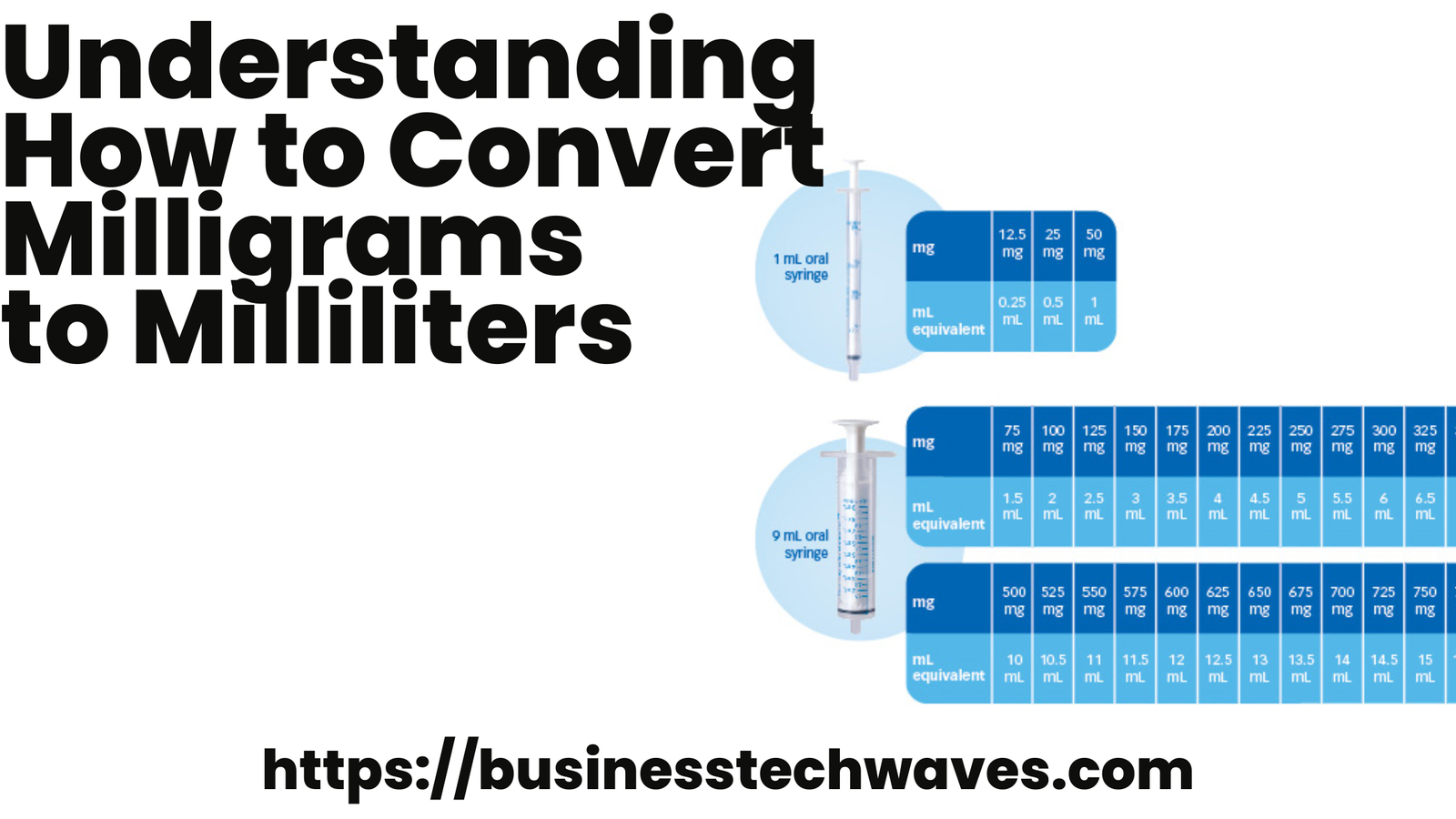
Best Understanding How to Convert Milligrams to ml 2024
Convert milligrams to ml is a fundamental calculation in various fields, including medicine, chemistry, and biology. However, this conversion can be challenging without understanding the basic principles underlying it. Milligrams measure mass, while milliliters measure volume. Because these units measure different things, Convert milligrams to ml between them requires an understanding of the substance’s density. This article will provide a comprehensive explanation of how to convert milligrams to milliliters, covering the concept of density, practical examples, and common applications of these conversions.
Understanding Units: Converting milligrams to ml
Milligram (mg) is a metric unit of mass equal to one-thousandth of a gram. It is often used in contexts where small quantities are involved, particularly in medicine for measuring doses of medications. For example, a tablet might contain 500 mg of an active ingredient.
Milliliter (ml) is a metric unit of volume that is equal to one-thousandth of a liter. It is frequently used in liquid measurements, especially in medicine, cooking, and chemistry. A milliliter is also equivalent to one cubic centimeter (cc or cm³). It is a small unit often used for liquids like water, oil, or medical solutions.
Because milligrams and milliliters measure different things—mass versus volume—there is no direct conversion between these units without knowing additional information: the density of the substance in question.
The Role of Density in Conversion
To convert milligrams to ml (or vice versa), you need to know the substance’s density. Density is defined as the mass per unit volume of a substance and is typically expressed in grams per milliliter (g/ml) for liquids or solids. The formula for density is:Density=MassVolume\text{Density} = \frac{\text{Mass}}{\text{Volume}}Density=VolumeMass
Rearranging this equation to solve for volume gives:Volume=MassDensity\text{Volume} = \frac{\text{Mass}}{\text{Density}}Volume=DensityMass
This formula is crucial when converting milligrams to milliliters because it shows that the volume (in milliliters) is equal to the mass (in milligrams) divided by the density (in g/ml). However, because milligrams are 1,000 times smaller than grams, an additional step is required to adjust the units accordingly.
Convert milligrams to ml: Step-by-Step
Let’s break down the steps involved in converting milligrams (mg) to milliliters (ml):
- Obtain the Density: The first step is to obtain the density of the substance you are working with. This can often be found in a textbook, datasheet, or online resource. For example, the density of water is approximately 1 g/ml, which means 1 gram of water occupies 1 milliliter of space. Other substances will have different densities; for instance, the density of ethanol is approximately 0.789 g/ml.
- Convert Density to Appropriate Units: Because density is usually expressed in grams per milliliter (g/ml), and you are working in milligrams, you need to convert grams to milligrams. Since 1 gram equals 1,000 milligrams, you need to adjust the density value. For example, a density of 1 g/ml would convert to 1,000 mg/ml.
- Apply the Formula: Once you have the density in milligrams per milliliter (mg/ml), use the formula:Volume (ml)=Mass (mg)Density (mg/ml)\text{Volume (ml)} = \frac{\text{Mass (mg)}}{\text{Density (mg/ml)}}Volume (ml)=Density (mg/ml)Mass (mg)
- Calculate the Volume: After applying the formula, you can calculate the volume in milliliters.
Example 1: Convert milligrams to ml for Water
Let’s take an example where we want to convert 500 mg of water into milliliters. The density of water is 1 g/ml, which converts to 1,000 mg/ml.
- Density of water = 1,000 mg/ml
- Mass = 500 mg
- Apply the formula:Volume (ml)=500 mg1,000 mg/ml=0.5 ml\text{Volume (ml)} = \frac{500 \, \text{mg}}{1,000 \, \text{mg/ml}} = 0.5 \, \text{ml}Volume (ml)=1,000mg/ml500mg=0.5ml
So, 500 mg of water is equivalent to 0.5 ml.
Example 2: Convert milligrams to ml for Ethanol
Now, consider you have 750 mg of ethanol and want to find its volume in milliliters. The density of ethanol is approximately 0.789 g/ml. Converting this to milligrams per milliliter:Density of ethanol=0.789 g/ml=789 mg/ml\text{Density of ethanol} = 0.789 \, \text{g/ml} = 789 \, \text{mg/ml}Density of ethanol=0.789g/ml=789mg/ml
Now, apply the formula:Volume (ml)=750 mg789 mg/ml≈0.95 ml\text{Volume (ml)} = \frac{750 \, \text{mg}}{789 \, \text{mg/ml}} \approx 0.95 \, \text{ml}Volume (ml)=789mg/ml750mg≈0.95ml
So, 750 mg of ethanol is approximately equal to 0.95 ml.
Why Density Matters
The two examples above highlight why density is crucial in converting milligrams to milliliters. Water and ethanol have different densities, so the same mass of each substance will occupy different volumes. Substances with higher densities will take up less volume for the same mass, while those with lower densities will occupy more space.
Without knowing the density, it is impossible to convert milligrams to ml accurately. This is because milliliters measure volume, which varies based on how tightly the substance’s molecules are packed (i.e., the density).
Common Applications of mg to ml Conversion
The conversion from milligrams to milliliters has several practical applications, particularly in fields where precise measurements of substances are critical. Here are a few examples:
1. Medical Dosages
In healthcare, accurate dosages are crucial, especially for intravenous (IV) medications, where drugs are often administered in liquid form. Doctors or nurses might need to convert a medication’s mass in milligrams to its equivalent volume in milliliters to ensure the correct dosage is given. For instance, if a medication has a density of 1.2 g/ml and the required dose is 600 mg, healthcare professionals would need to calculate how many milliliters to administer.
2. Pharmaceuticals and Chemistry
Pharmaceutical companies frequently use the mg-to-ml conversion to formulate medications. When creating liquid formulations, they must know how much of the active ingredient in milligrams corresponds to a given volume. This process ensures that each dose delivers the correct amount of medication.
Similarly, in chemical laboratories, scientists often work with reagents and compounds in both mass and volume form. Knowing how to convert between milligrams and milliliters is essential for creating solutions with precise concentrations.
3. Food and Beverage Industry
In the food and beverage industry, small amounts of certain ingredients, such as preservatives or additives, may be measured in milligrams. When these ingredients are added to liquids, manufacturers need to know how to convert their mass to volume to achieve the correct mixture.
4. Cosmetics and Personal Care
In the production of cosmetics, manufacturers must ensure that their formulations contain the correct proportion of active ingredients. This often requires converting milligrams of an ingredient (such as vitamins or oils) to milliliters of a liquid solution.
Conversion Tools and Calculators
While it’s possible to manually perform the conversion as described above, several online calculators and mobile apps simplify the process. These tools often allow users to input the mass and density of a substance to get an instant conversion to volume.
In practice, though, it’s always important to double-check the density value you use, especially when precision is critical, as even small errors in density can lead to significant discrepancies in the final volume.
Conclusion
Convert milligrams to ml is not a straightforward conversion because the two units measure different properties: mass and volume. To make this conversion, you need to know the density of the substance, which provides the link between mass and volume. By applying the formula that relates mass, volume, and density, you can accurately convert milligrams to milliliters for any substance. This process is particularly important in fields like medicine, chemistry, and industry, where precise measurements are essential. Understanding these conversions ensures accuracy in applications where even small errors could have significant consequences.


